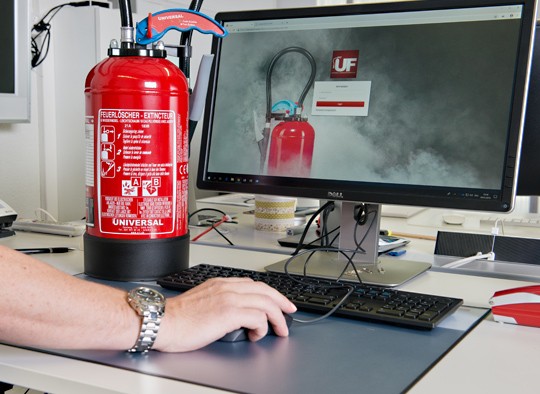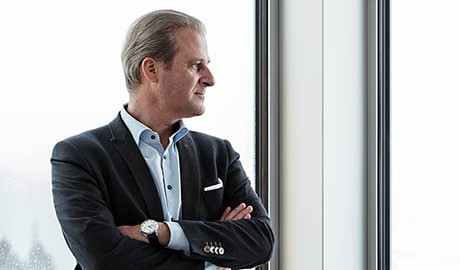Internet of Things for smart buildings
A burning passion for the Internet of Things
Marcel Wyss, owner of Universal Feuerlöschgeräte AG, has invented the IoT-ready fire extinguisher with sensor technology built into the handle to detect and report tampering – via the low power network. This ensures that the smart fire extinguishers are always handy and ready to use.
Text: Christoph Widmer, Images: Manuel Zingg, Video: TinCan Motion, 28 june 2019
45-year-old Marcel Wyss loves his job. The humorous, good-natured Solothurn native is a creator, innovative visionary and has a burning passion for digitalisation – and everything involving firefighting. Once, for a Christmas card sent to customers, he burned a fir tree and towed it to the photo studio – together with his bushy-bearded, 76-year-young former colleague Erich Wälti – dressed as Santa Claus and with a fire extinguisher under his arm.
The solution was tested a year and a half ago – now the smart fire extinguisher is ready for series production. Executive Director Marcel Wyss explains in the video how the solution can prevent dangerous fires.
Digitalisation is an opportunity
Marcel’s enthusiasm for firefighting is relatively new. A plumber by training, he spent many years working mainly in sales in ‘his’ industry. That was until one day his father-in-law asked him if he would be interested in following in his footsteps and taking over the family business, which was founded in 1973. Marcel accepted. He climbed on board as Chief Executive in 2016 and acquired the company in 2017. He has been leading the nine-person team ever since, which also includes his wife, four service technicians, two office staff, an accountant and the office dog, Gina. ‘After learning the ropes, I began closely examining the processes, challenging the way things were already being done, exploring the question of a unique selling proposition, which is essential for the survival of any SME that wants to succeed in a competitive market,’ he says.
Marcel is convinced: ‘The Internet of Things is opening doors to new markets for us.’
The Internet of Things is improving safety
Marcel found out something directly from the customers: ‘Our service technicians repeatedly found that – particularly in large, publicly accessible buildings or spaces – fire extinguishers were being removed from their locations, tampered with or activated without anyone being notified. This is a fire hazard in the most literal sense. After all, if there’s a fire, the fire extinguisher has to be accessible and usable immediately!’
It became clear to him that they needed a reliable, simple and inexpensive device that triggers an alarm whenever a fire extinguisher has been tampered with or removed from its normal place. Following some intensive research, he came across the solution while attending the Sicherheit 2017 trade fair in Zurich: the Internet of Things. ‘I talked to experts there and learned about IoT sensors connected to the internet via Swisscom’s LoRaWAN. I knew right away that this was exactly what we needed.’

Updates and status notifications can now be automated centrally. Customers are only contacted when there is a problem.
Fast maintenance thanks to LoRaWAN
He consulted with the experts from Swisscom – and got to work with them. A CRM system was developed and a catalogue of requirements for the sensors was prepared, which was then further developed by Comtac AG, a Flurlingen-based company specialising in IoT devices. At the end of 2018, after one and a half years of hard work and six-figure investments, the first smart fire extinguisher was ready for series production. Its IoT sensor technology detects whether the locking splint on the handle has been tampered with or removed and if the fire extinguisher has been taken out of its holder. In the event of both tampering and removal, a notification is sent to the CRM system – via Swisscom’s LoRaWAN-based low power network (LPN). This allows Marcel to immediately notify the customer and dispatch a service technician, who then locates the intelligent fire extinguisher, inspects it, repairs it if needed and then puts it back in its place. ‘That way, our customers can be sure that their fire extinguishers are always where they should be and are ready to use. ‘This is our unique selling proposition in the industry and is opening the door to new markets,’ he firmly believes.
Faster than the fire brigade
The IoT pioneer from Bern is already thinking about new possibilities for the future as well. ‘Essentially, we could use the system to notify the fire brigade directly, such as when multiple fire extinguishers in close proximity are removed from their holders in quick succession. Then it’s pretty clear that there is a fire – and thanks to the automatic alarm, the fire brigade can arrive at the location much sooner.’
The smart fire extinguisher
- Small, rugged sensor technology built into the handle
- Existing Universal-brand foam and powder extinguishers can be retrofitted
- Secure data transmission via LoRaWAN-based IoT connectivity from Swisscom (LPN/low power network)
- Nine-year battery life
- Test function for battery level and wireless connection
Universal Feuerlöschgeräte AG
- Founded: 1973
- Company size: 9 employees
- Structure: traditional Swiss SME, family-operated
- Products: Fire extinguishers (resale), fire hose cabinets (produced in-house), industrial extinguishing systems, fire protection technology and training
- www.u-f.ch
Smart buildings thanks to IoT ecosystems
Truly smart buildings are only possible through the combination of various IoT providers. With the expansion of the low power network (LPN) from Swisscom, the NeoVac Group is making an important contribution to the development of IoT ecosystems. This is how LoRaWAN is making its way deep inside of the building and laying the foundation for another IoT case. Numerous applications are possible, ranging from simple building management solutions to intelligent locking systems. In addition, costs can be reduced thanks to measurement and monitoring of room temperature. This not only benefits owners and building managers, but tenants as well.
Swisscom Indoor Connectivity
Networking devices inside buildings is no easy undertaking: thick walls, materials with shielding properties, such as concrete and steel, and areas deep underground impede the transmission of radio signals. While closed systems can help, devices made by other IoT providers are difficult to integrate into the network. Added to this, it is not always possible to guarantee a direct external power line to the sensors, meaning that the devices need to have a long battery life.
New IoT access technologies from Swisscom, such as the low-power network (LPN) or advanced Narrowband-IoT mobile communication standard, are ideal for data transmission inside buildings. They meet IoT-specific requirements, such as high network independence, high availability and security. The narrow bandwidth and large range enable reliable data transmission with low energy consumption – no matter where the sensors are located. Swisscom is implementing LPN and Narrowband-IoT for the national IoT expansion – and establishing a standard for countless new IoT ecosystems and digital applications.

Newsletter
Would you like to regularly receive interesting articles and whitepapers on current ICT topics?
More on the topic


